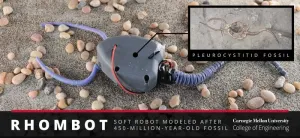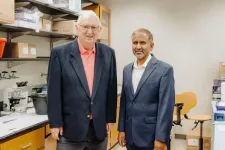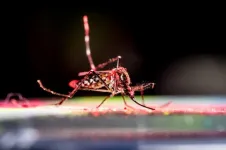(Press-News.org) PITTSBURGH—Researchers in the Department of Mechanical Engineering at Carnegie Mellon University, in collaboration with paleontologists from Spain and Poland, used fossil evidence to engineer a soft robotic replica of pleurocystitid, a marine organism that existed nearly 450 million years ago and is believed to be one of the first echinoderms capable of movement using a muscular stem.
Published today in The Proceedings of the National Academy of Science (PNAS), the research seeks to broaden modern perspective of animal design and movement by introducing a new a field of study - Paleobionics - aimed at using Softbotics, robotics with flexible electronics and soft materials, to understand the biomechanical factors that drove evolution using extinct organisms.
“Softbotics is another approach to inform science using soft materials to construct flexible robot limbs and appendages. Many fundamental principles of biology and nature can only fully be explained if we look back at the evolutionary timeline of how animals evolved. We are building robot analogues to study how locomotion has changed,” said Carmel Majidi, lead author and Professor of Mechanical Engineering at Carnegie Mellon University.
With humans’ time on earth representing only 0.007% of the planet’s history, the modern-day animal kingdom that influences understanding of evolution and inspires today’s mechanical systems is only a fraction of all creatures that have existed through history.
Using fossil evidence to guide their design and a combination of 3D printed elements and polymers to mimic the flexible columnar structure of the moving appendage, the team demonstrated that pleurocystitids were likely able to move over the sea bottom by means of a muscular stem that pushed the animal forward. Despite the absence of a current day analogue (echinoderms have since evolved to include modern day starfish and sea urchins), pleurocystitids have been of interest to paleontologists due to their pivotal role in echinoderm evolution.
The team determined that wide sweeping movements were likely the most effective motion and that increasing the length of the stem significantly increased the animals’ speed without forcing it to exert more energy.
“Researchers in the bio-inspired robotics community need to pick and choose important features worth adopting from organisms,” explained Richard Desatnik, PhD candidate and co-first author.
“Essentially, we have to decide on good locomotion strategies to get our robots moving. For example, would a starfish robot really need to use 5 limbs for locomotion or can we find a better strategy?” added Zach Patterson, CMU alumnus and co-first author.
Now that the team has demonstrated that they can use Softbotics to engineer extinct organisms, they hope to explore other animals, like the first organism that could travel from sea to land – something that can’t be studied in the same way using conventional robot hardware.
“Bringing a new life to something that existed nearly 500 million years ago is exciting in and of itself, but what really excites us about this breakthrough is how much we will be able to learn from it,” said Phil LeDuc, co-author, and Professor of Mechanical Engineering at Carnegie Mellon University. “We aren’t just looking at fossils in the ground, we are trying to better understand life through working with amazing paleontologists.”
Additional collaborators include Przemyslaw Gorzelak, Institute of Paleobiology, Polish Academy of Sciences, and Samuel Zamora, The Geological and Mining Institute of Spain.
More information:
Paleobionics: Soft robotics informs how early echinoderms moved, The Proceedings of the National Academy of Sciences
###
About the College of Engineering: The College of Engineering at Carnegie Mellon University is a top-ranked, engineering college that is known for our intentional focus on cross-disciplinary collaboration in research. The College is well known for working on problems of both scientific and practical importance. Our acclaimed faculty have a focus on innovation management and engineering to yield transformative results that will drive the intellectual and economic vitality of our community, nation and world. The College offers graduate and undergraduate degree programs in biomedical engineering, chemical engineering, civil and environmental engineering, electrical and computer engineering, engineering and public policy, information networking, materials science and engineering and mechanical engineering. Our “maker” culture is ingrained in all that we do, leading to novel approaches and transformative results.
END
City lights shine all night amid the bustling traffic, businesses and neighborhoods of Southern California, one of the most populated areas that mountain lions call home.
A study from the University of California, Davis, found that mountain lions avoid places with artificial light, even during the day. The finding adds to the list of challenges faced by the big cats in the region, where scientists have warned they may face extinction within decades.
The new study, published in the journal Philosophical ...
A drug candidate developed by researchers at the University of Tennessee Health Science Center for advanced metastatic castration-resistant prostate cancer is now in its first clinical trial.
Ramesh Narayanan, PhD, deputy director of the Center for Cancer Research and the Muirhead Endowed Professor in the College of Medicine at UTHSC, and Duane Miller, PhD, Professor Emeritus in the Department of Pharmaceutical Sciences at UTHSC, have worked for more than a decade on therapies involving the hormone receptors that influence cancer progression. Their drug candidate, a molecule designed as a treatment for ...
A new mathematical model predicts that mammalian sperm cells have two distinct swimming modes. This prediction opens new questions about potential connections between sperm cells’ motor activity and their transitions to hyperactivation phases that may play an important role in fertilization. The finding is part of a larger effort to use math and fluid dynamics to describe how mammalian sperm move. The research is led by a team of engineers at the University of California San Diego. The new work is published in the journal Physical ...
NEW ORLEANS, La. – Several Ochsner Health hospitals and partners across the Gulf South have earned an ‘A’ Leapfrog Hospital Safety Grade for Fall 2023.The Leapfrog Group, a national nonprofit watchdog that sets standards for excellence in patient care, assigns a grade to general hospitals across the country based on more than 30 national performance measures reflecting errors, accidents, injuries and infections, as well as the systems hospitals have in place to prevent them.
The following Ochsner Health hospitals and partners received an ...
Technology is edging closer and closer to the super-speed world of computing with artificial intelligence. But is the world equipped with the proper hardware to be able to handle the workload of new AI technological breakthroughs?
“The brain-inspired codes of the AI revolution are largely being run on conventional silicon computer architectures which were not designed for it,” explains Erica Carlson, 150th Anniversary Professor of Physics and Astronomy at Purdue University.
A joint effort between Physicists from Purdue University, University of California San Diego (USCD) and École ...
Researchers at the Beckman Institute for Advanced Science and Technology developed an automated laboratory robot to run complex electrochemical experiments and analyze data.
With affordability and accessibility in mind, the researchers collaboratively created a benchtop robot that rapidly performs electrochemistry. Aptly named the Electrolab, this instrument greatly reduces the effort and time needed for electrochemical studies by automating many basic and repetitive laboratory tasks.
The Electrolab can be used to explore energy storage materials and chemical reactions that promote the use of alternative ...
The fight against dengue fever has a new weapon: a mosquito infected with the bacteria Wolbachia, which prevents the spread of the virus. These mosquitoes have now been deployed in several trials demonstrating their potential in preventing disease transmission.
Now, researchers at the University of Notre Dame have conducted an analysis of the World Mosquito Program’s randomized control trial of Wolbachia-infected mosquitoes in Indonesia, looking at how excluding transmission dynamics impacted the original interpretation of the trial’s results.
“Randomized controlled trials are the gold standard for evaluating the efficacy of any ...
“Our research study has demonstrated that poziotinib is highly potent in neratinib-resistant HER2 L755S lobular and ductal breast cancer models [...].”
BUFFALO, NY- November 6, 2023 – A new editorial paper was published in Oncotarget's Volume 14 on October 31, 2023, entitled, “The uncharted role of HER2 mutant alleles in breast cancer.”
Somatic HER2 mutations are a novel class of therapeutic targets across different cancer types. Treatment with the tyrosine kinase inhibitor (TKI) neratinib ...
WASHINGTON – Warren Wood, Ph.D., U.S. Naval Research Laboratory Ocean Sciences Division’s Geology and Geophysics section head, received the National Defense Industrial Association (NDIA) Bronze Medal on Sept. 19, 2023 during a ceremony held at the Naval Submarine Base in Groton, Conn. for outstanding individual achievement in undersea warfare.
This award-winning work would not have been possible without fantastic teamwork, especially from the staff in Geology and Geophysics and Acoustic Simulation, Measurements & Tactics Branches,” said Wood. “Essentially a software ...
A new study, "Timing of Orthostatic Hypotension and its Relationship with Falls in Older Adults", has brought critical insights into the assessment of orthostatic hypotension, a drop in blood pressure commonly found among older adults when transitioning from a sitting or lying position to a standing position that can lead to dizziness and falls.
Published in the Journal of the American Geriatrics Society (JAGS) and based on a secondary analysis of the "Study to Understand Fall Reduction and Vitamin D in You (STURDY)," this study examined the prevalence of orthostatic hypotension at different time points after ...






